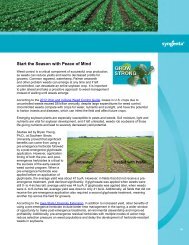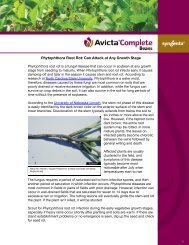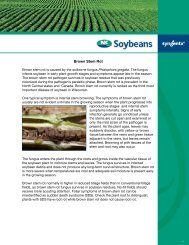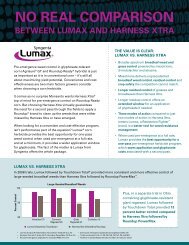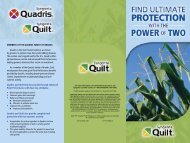Paper
Using Water-Sensitive Paper - FarmAssist
Using Water-Sensitive Paper - FarmAssist
- No tags were found...
You also want an ePaper? Increase the reach of your titles
YUMPU automatically turns print PDFs into web optimized ePapers that Google loves.
Handling and Storing<br />
By following the guidelines below, the integrity of Water-Sensitive <strong>Paper</strong> remains intact, which ensures<br />
the accuracy of your results.<br />
Handling<br />
• Be sure to wear gloves when touching the Water-Sensitive <strong>Paper</strong> to prevent moisture from being<br />
transferred onto the paper.<br />
• Make sure it is dry where you attach the paper. This way the paper will only pick up the spray,<br />
not extraneous water.<br />
• It’s a good idea to photocopy results to allow for later evaluation and record keeping.<br />
Storage<br />
• Water-Sensitive <strong>Paper</strong> can be stored up to 10 years if it remains in its original package and the<br />
packaging isn’t damaged.<br />
• Once the strips have been used, they must be stored in dry conditions, like an airtight box or bag.<br />
• After exposure, strips can be protected in plastic sleeves or with a thin, clear, adhesive tape<br />
(be sure to apply it without air bubbles).<br />
Water-Sensitive<br />
<strong>Paper</strong><br />
An Innovative Solution<br />
Over the past 20 years, Syngenta Crop Protection has developed a way<br />
to monitor spray distribution in your fields to help ensure optimized<br />
application of fungicides, herbicides and insecticides to a variety of<br />
crops and plants. Water-Sensitive <strong>Paper</strong> is a rigid, yellow paper<br />
designed to turn dark blue when aqueous drops contact it.<br />
Ideal spray<br />
This is an example of an ideal spray.<br />
Coverage and droplet size are even<br />
and consistent, illustrating proper<br />
product coverage.<br />
Improper Application<br />
This is an example of an improper<br />
application. Coverage and droplet size<br />
are not even and consistent, illustrating<br />
improper product coverage and poor<br />
application calibration.<br />
Handling Error<br />
This is an example of a handling error.<br />
Always wear gloves when touching the<br />
paper to prevent transfer of moisture<br />
from your hands to the paper.<br />
This provides an instant visual of the spray distribution<br />
and droplet size, allowing growers to adjust sprayer<br />
settings to achieve optimal spray patterns.<br />
Water-Sensitive <strong>Paper</strong> confirms the actual<br />
spray pattern on the target surfaces in the field.<br />
For more information, visit the Syngenta Crop Protection website at www.syngentacropprotection.com or www.farmassist.com<br />
or call 866-SYNGENTA (866-796-4368).<br />
©2007 Syngenta. Syngenta Crop Protection, Inc. Greensboro, NC 27409. Important: Always read and follow label instructions before buying or using these products.<br />
Syngenta Crop Protection, Inc. warrants that its products conform to the chemical description set forth on the products’ labels. NO OTHER WARRANTIES, WHETHER EXPRESS OR<br />
IMPLIED, INCLUDING WARRANTIES OF MERCHANTABILITY AND OF FITNESS FOR A PARTICULAR PURPOSE, SHALL APPLY TO SYNGENTA PRODUCTS. Syngenta Crop Protection, Inc.<br />
neither assumes nor authorizes any representative or other person to assume for it any obligation or liability other than such as is expressly set forth herein. IN NO EVENT SHALL<br />
SYNGENTA CROP PROTECTION, INC. BE LIABLE FOR INCIDENTAL, CONSEQUENTIAL OR SPECIAL DAMAGES RESULTING FROM ANY USE OR HANDLING OF ITS PRODUCTS.<br />
No statements or recommendations contained herein are to be construed as inducements to infringe any relevant patent now or hereafter in existence.<br />
Syngenta and the Syngenta logo are trademarks of a Syngenta Group Company.<br />
GS 407.60515 (08/07)<br />
SCP 007-00020-A
A Closer Look – About Water-Sensitive <strong>Paper</strong><br />
Aerial Applications Fine Fine Medium Medium Coarse Coarse<br />
Once attached to the plant and contacted by spray droplets, the Water-Sensitive <strong>Paper</strong> immediately turns a dark blue<br />
color at the impact site. The paper can be used for ground or aerial applications and can be analyzed for uniformity,<br />
area covered, droplet density, and relative droplet size with the naked eye, a hand lens or an automatic image analyzer.<br />
Why Use Water-sensitive <strong>Paper</strong>?<br />
• Reacts to sprays on contact for immediate results<br />
• Provides a precise record of spray deposition<br />
• Reveals spray pattern uniformity and droplet density<br />
• Provides visual approximation of the spray droplet size spectrum<br />
• Reduces costs by promoting efficient spray levels<br />
• Provides information to increase spray consistency for more uniform plant protection<br />
• Works without the addition of dye or other additives that could influence results<br />
• Measures coverage, droplet density, and relative droplet size simultaneously, giving all necessary<br />
pattern information in one step<br />
In aerial applications, place cards<br />
at six- to nine-foot intervals over a<br />
three-run swath width.<br />
Gallons per Acre 2.0 5.0 2.0 5.0 2.0 5.0<br />
Airblast Applications Fine Fine Fine Fine Fine Fine<br />
About Droplet Size and Spray Distribution<br />
The ideal amount of coverage varies by the type of application and the product being used. On the following<br />
page, spray application examples are shown for aerial, airblast sprayer and boom sprayer application equipment.<br />
General coverage recommendations are as follows; use label recommendations if different:<br />
• Fine coverage: insecticides<br />
• Medium coverage: post-emergence contact herbicides<br />
• Coarse coverage: fungicides, pre-emergence herbicides<br />
In airblast applications, staple each<br />
end of the paper directly to leaves<br />
at the top, middle and bottom of the<br />
tree, as well as on the sides.<br />
Using Water-Sensitive <strong>Paper</strong><br />
Percent Coverage 0.3 1.0 3.0 8.0 15.0 78.0<br />
To get the best results from Water-Sensitive <strong>Paper</strong>, the paper must be correctly applied following the instructions below:<br />
• Number the Water-Sensitive <strong>Paper</strong>s or write their positions on the back so you know where each paper was<br />
during the application. Keep a key to identify starting points.<br />
Boom Spray Applications Fine Fine Medium Medium Coarse Coarse<br />
• When attaching the paper to leaves, apply a piece near the top, near the base and in the middle of the plant or<br />
tree. Also apply pieces on each side at mid-height. This gives the best assessment of where the spray is hitting<br />
and what areas are missed.<br />
• In aerial applications, place paper at six- to nine-foot intervals over a three-run swath width.<br />
• Wear gloves when placing papers on soil or leaves to keep your fingers from applying moisture onto the paper,<br />
and be sure the leaves are dry.<br />
• Staple the paper at both ends so it is securely attached to the leaf.<br />
• Check to make sure the paper has not changed the leaf’s orientation.<br />
• After the application, wait until the paper is fully dried before removal. Also, be sure to wear gloves to<br />
preserve the sample.<br />
In boom spray applications, staple<br />
the paper to leaves or a wooden<br />
lath across a single-run width,<br />
leaving a gap for tractor wheels.<br />
Gallons per Acre 10 20 10 20 10 20



